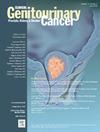Incidence of Significant Prostate Cancer in the Follow-Up of Patients With Suspicious Lesion on MRI and Negative Targeted and systematic Biopsies
IF 2.3
3区 医学
Q3 ONCOLOGY
引用次数: 0
Abstract
Introduction
Currently, there are no established guidelines for follow-up (FU) after negative prostate biopsies (PBx) despite the presence of a target on MRI. We aimed to evaluate the risk of clinically significant prostate cancer (csPCa) within 2 years (2y) and at final FU in such cases.
Patients and Methods
We analyzed 105 patients with negative systematic and targeted PBx despite positive mpMRI (PI-RADS ≥ 3) (median FU: 66.5 months [IQR: 40-83]). All patients underwent FU with serial PSA measurements, digital rectal examinations and, when indicated, FU-MRI and/or FU-PBx. Outcomes assessed csPCa occurrence (GGG /ISUP ≥ 2) at 2y and at final FU, and predictive factors for csPCa.
Results
At 2y, the csPCa detection rate (Det-R) was 7.6%, increasing to 15.2% at final FU. No significant differences were observed at 2y based on baseline PI-RADS status. The mean initial PSAD was significantly higher in patients with csPCa at 2y versus without: 0.20 ng/mL² (SD: 0.11) versus 0.13 ng/mL² (SD: 0.12) (P = .008). Patients with baseline PSAD > 0.15 had a significantly higher 2y csPCa Det-R versus with PSAD < 0.15: 18.2% (4/22) versus 3.7% (3/81) (P = .036). The combination of PSAD < 0.15 and PI-RADS 3 at baseline was associated with a very low 2y csPCa Det-R (3%, 1/34), compared to PSAD > 0.15 and PI-RADS ≥ 4 (23%, 3/13).
At final follow-up: 53% of patients with csPCa had an increasing PSAD (vs. 14% without, P = .003). A total of 41% (43/105) of patients underwent FU-MRI. Patients with csPCa were significantly more likely to have upgraded MRI findings (56% vs. 2.2%, P < .001).
Conclusion
Following negative PBx despite a positive mpMRI, the risk of csPCa was low. However, careful monitoring is essential, particularly in cases of PSAD > 0.15, and/or PI-RADS ≥ 4 at baseline. FU-PSAD and FU-MRI emerged as the most significant predictive factors, aiding to stratify the need for FU-PBx.
求助全文
约1分钟内获得全文
求助全文
来源期刊

Clinical genitourinary cancer
医学-泌尿学与肾脏学
CiteScore
5.20
自引率
6.20%
发文量
201
审稿时长
54 days
期刊介绍:
Clinical Genitourinary Cancer is a peer-reviewed journal that publishes original articles describing various aspects of clinical and translational research in genitourinary cancers. Clinical Genitourinary Cancer is devoted to articles on detection, diagnosis, prevention, and treatment of genitourinary cancers. The main emphasis is on recent scientific developments in all areas related to genitourinary malignancies. Specific areas of interest include clinical research and mechanistic approaches; drug sensitivity and resistance; gene and antisense therapy; pathology, markers, and prognostic indicators; chemoprevention strategies; multimodality therapy; and integration of various approaches.
 求助内容:
求助内容: 应助结果提醒方式:
应助结果提醒方式:


